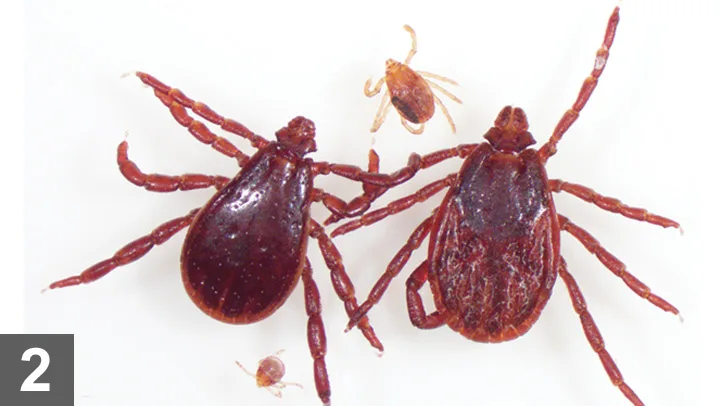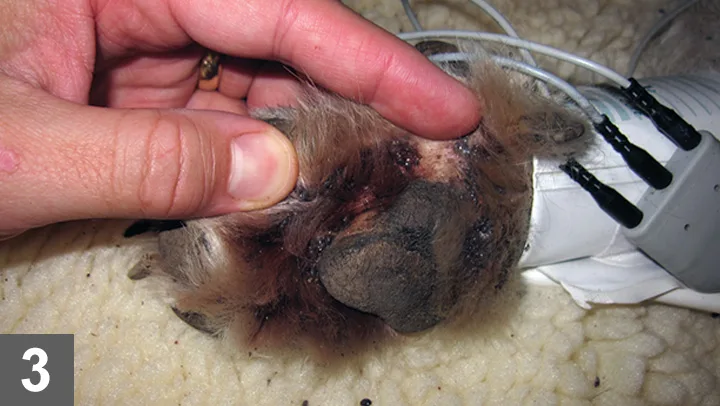Managing Canine Tick Infestation

You have asked
How do I manage tick infestations on a dog?
The expert says
Ticks are common ectoparasites of all land mammals and birds. As arachnids (Acari), ticks are not susceptible to many insecticides commonly used to control fleas or lice. Ideally, dogs would be protected from ticks through proactive, routine use of acaricides (ie, tick control products) with residual activity prior to exposure to areas harboring ticks; however, when the veterinary team does not recommend tick control to clients and/or clients do not use routine tick control, severe infestations can occur.
The best approach for managing an infestation depends on the tick species.
The best approach for managing a tick infestation depends on the tick species. The most common tick species associated with dogs in North America are 3-host ticks, with each stage detaching after feeding to molt in the environment and then reattaching to a new host in the next stage, and include the Lone Star tick, Amblyomma americanum; the American dog tick, Dermacentor variabilis; the blacklegged tick or deer tick, Ixodes scapularis and I pacificus; and the brown dog tick, Rhipicephalus sanguineus.
Related Article: When Tick Populations are Out of Control
Ticks can be readily identified by consulting online resources or widely available tick identification guides (tickencounter.org, CDC.gov/ticks). All tick species have a life cycle that involves egg, larva, nymph, and adult stages. The feeding stages of the wildlife ticks (eg, Amblyomma spp, Dermacentor spp, Ixodes spp) may occur on a variety of different wildlife hosts and on dogs, whereas those of R sanguineus have a strong host preference for domestic dogs and are usually only found in and around homes and kennels where dogs live. Of the 4 most common species, only brown dog ticks are capable of infesting buildings (homes, barns, kennels) and can reach massive numbers in very close quarters with dogs, cats, and humans (Figure 1).

Figure 1. Brown dog tick infestation between the toes of a heavily infested Great Pyrenees dog.
Common Tick Species
Amblyomma americanum (Lone Star Tick)
Lone Star ticks are found throughout most of the eastern and southern United States, and although both immature and adult ticks are commonly associated with deer, these ticks feed on a variety of mammalian and avian hosts. In dogs, the Lone Star tick is a vector for agents of ehrlichiosis, spotted fever group rickettsiosis, and tularemia. They also transmit the agent of cytauxzoonosis to cats as well as a number of zoonotic viral and bacterial organisms.
Dermacentor variabilis (American Dog Tick)
American dog ticks are distributed widely across North America but are not seen in large numbers along the Rocky Mountain range or the desert West. As adults, these ticks prefer to feed on dogs and other medium-sized mammals but will feed on a variety of mammals, including horses, humans, dogs, deer, and cattle. Dermacentor spp ticks are also vectors of ehrlichiosis, tularemia, and spotted fever group rickettsial species including Rickettsia rickettsii (the causing agent of Rocky Mountain Spotted Fever), ehrlichiosis agents, and tularemia.
Ixodes scapularis & Ixodes pacificus (Blacklegged Tick or Deer Tick)
Blacklegged ticks (or deer ticks) are found throughout the eastern and midwestern United States and Canada (I scapularis) and west of the Rocky Mountain range (I pacificus). Ixodes spp feed on rodents, birds, and other small mammals as larvae and nymphs and on larger mammals, including dogs, as adults. These ticks are a vector for the agents of Lyme disease, granulocytic anaplasmosis, novel ehrlichiosis caused by an E muris-like organism, tick-borne encephalitis virus, and human babesiosis.
Rhipicephalus sanguineus (Brown Dog Tick)
Brown dog ticks, also referred to as kennel ticks, have adapted to a wide variety of climates, including hot and arid areas in the southwestern United States, and can be found worldwide wherever there are dogs. Brown dog ticks have a strong preference for domestic dogs, and both immature and adult stages will feed on the same individual hosts if necessary to complete the life cycle. Brown dog ticks occasionally feed on other mammals, including humans and cats when dogs are not available. This tick is a vector for the agents of a number of canine diseases, including ehrlichiosis, babesiosis, Rocky Mountain Spotted Fever, hepatozoonosis caused by Hepatozoon canis, and anaplasmosis caused by Anaplasma platys.
Tick Control in the Environment
Most ticks in the environment quest or seek out a host by climbing brush, grasses, walls, or fences, waiting for movement or exhaled carbon dioxide as a signal to move to their desired host. Removal of brush and leaf litter and maintaining grass at a shorter height makes it difficult for ticks to find areas to quest and gain access to the dog. When environment modification is not possible, it may be appropriate to restrict the dogs access from areas harboring ticks. Restricting a dogs access from crawl spaces and gaps underneath kennels can help prevent reacquisition of brown dog ticks while limiting the time spent in wooded areas may prevent infestations with Lone Star ticks and deer ticks. Similarly, avoiding grassy overgrown meadows may help reduce acquisition of American dog ticks.
Application of acaricides to the environment is usually only necessary or effective for the control of R sanguineus ticks on premises. A licensed pest control applicator should be consulted for advice. Areas under structures should be treated as well as vertical surfaces such as walls and fences.
Tick Control on the Dog
There are many different options for treating dogs to prevent or limit tick infestations, including amitraz, fipronil, pyrethroids, and oral isoxazolines such as fluralaner and afoxolaner. Amitraz is an effective acaricide available in a collar formulation; previous liquid spot-on formulations marketed for tick control are no longer available. Fipronil has been widely used in the United States for many years and is available in spray and spot-on formulations. Current spot-on formulations often combine fipronil with a pyrethroid to boost the acaricidal activity of the product. Pyrethroids are a widely used class of chemicals for the control of ticks on dogs and include collars and spot-on products containing cyphenothrin, deltamethrin, flumethrin, or permethrin. Pyrethroids are the only class of acaricide used on dogs that have repellent activity. Recently, isoxazolines, including afoxolaner and fluralaner, have become available and provide effective tick control via oral administration to dogs.
Related Article: Flea & Tick Treatment Options
Figure 2. Larva, nymph, adult male, and adult female brown dog tick, Rhipicephalus sanguineus. Courtesy of National Center for Veterinary Parasitology, Oklahoma State University.

Severe Infestation on the Dog
Because ticks feed on whole blood, there is the possibility of blood loss anemia if a large number of ticks feed simultaneously. This scenario is most commonly seen in premises where dogs harbor large numbers of R sanguineus ticks. Although the inflammation associated with a single tick bite is usually mild, hundreds or thousands of simultaneous tick bites can result in severe dermatitis with inflammation and protein loss through the skin. Tick bite wounds are susceptible to secondary bacterial colonization; topical antimicrobial shampoos or washes or perhaps oral antibiotics may be appropriate in severe infestation cases. Control of a tick infestation on a severely debilitated animal must begin with removal of the animal from the environment so that both the patient and the environment can be adequately treated. Sprays, shampoos, or oral medications should be considered for these patients so that acaricides are rapidly delivered to all tick attachment sites.
Figure 3. Large numbers of nymphal ticks clustered in the interdigital space of a dog. It is unlikely that spot-on products will reach acaricidal concentrations on distal locations such as the foot. A topical spray may be a more appropriate choice in the face of a severe infestation.

Figure 4. Heavy infestation of feeding young and adult ticks. The hair surrounding the ticks is darkened with tick frass and dried serous exudate.

Tick-Associated Disease
Identification of tick species can also provide valuable information regarding potential infectious disease risk. Large numbers of blacklegged or deer ticks may raise the index of suspicion for Lyme borreliosis or anaplasmosis if the patient originates from an endemic area, whereas large numbers of brown dog ticks might suggest the presence of disease caused by a rickettsial or protozoal agent. Tick paralysis should be considered in any acutely paralyzed dog with no evidence of trauma.
Routine prophylactic use of an antibiotic is not necessary or recommended after exposure to a single tick bite or a small number of ticks. In cases of severe infestation where there are hundreds or thousands of tick bites, the exposure risk is high enough that it may be appropriate to provide prophylactic antibiotics while simultaneously addressing the infestation on the dog and in the environment. Because the most likely tick associated with such large infestations is R sanguineus and this tick is a common vector for rickettsial agents, the use of a tetracycline antibiotic (doxycycline, minocycline) would be an appropriate choice in cases of severe brown dog tick infestations.
AARON HERNDON, DVM, DACVIM (SAIM), is a lecturer in small-animal medicine at Oklahoma State University Center for Veterinary Health Sciences. A graduate of Texas A&M University, Dr. Herndon is completing the requirements to earn a doctorate of philosophy in veterinary biomedical sciences.
SUSAN LITTLE, DVM, PhD, DACVM (Parasitology), is a regents professor and Krull-Ewing endowed chair in veterinary parasitology at Oklahoma State University, where she oversees a research program focused on ticks and tick-borne diseases. A past-president of the American Association of Veterinary Parasitologists, Dr. Little is co-director of the National Center for Veterinary Parasitology and the president of the Companion Animal Parasite Council. She frequently presents at the annual North American Veterinary Community Conference.